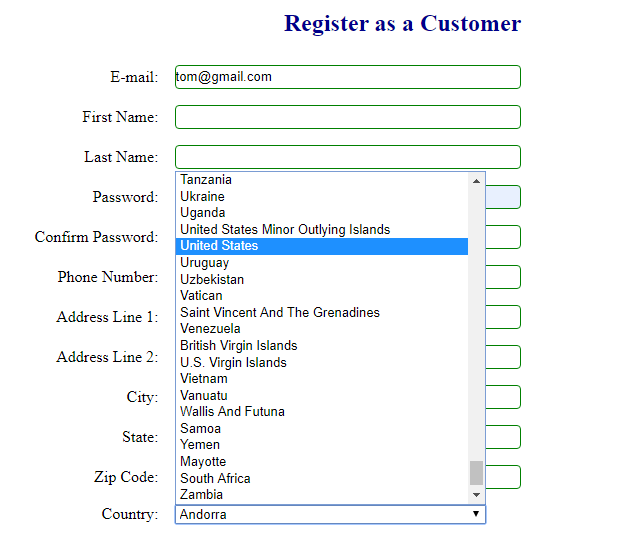How to code country dropdown list in Java Servlet and JSP
- Details
- Written by Nam Ha Minh
- Last Updated on 07 November 2019 | Print Email
Showing a list of country for the user to select is a very common requirement. But it’s very difficult, time-consuming and inaccurate if you write code manually. It’s even painful if you copy and paste the code of country list from somewhere because the list is very long.
So in this post, you will learn a quick, simple and best way to generate a list of all countries in the world and show it in a dropdown list in a webpage that looks like this:

Follow the steps below to code a dropdown list of countries with Java Servlet and JSP.
1. Get a list of countries and regions
We take advantage of the Internationalization (i18n) API in Java to get an ISO-standard list of countries and regions. Consider this example program:
package net.codejava;
import java.util.Locale;
public class CountryList {
public static void main(String[] args) {
String[] countryCodes = Locale.getISOCountries();
System.out.println("Number of countries and regions: " + countryCodes.length);
for (String countryCode : countryCodes) {
Locale locale = new Locale("", countryCode);
String code = locale.getCountry();
String name = locale.getDisplayCountry();
System.out.printf("[%s] %s\n", code, name);
}
}
}Run this program and it will print a list of 250 countries and regions (country code in the brackets) as below:
Number of countries and regions: 250 [AD] Andorra [AE] United Arab Emirates [AF] Afghanistan [AG] Antigua and Barbuda ... [IL] Israel [IM] Isle Of Man [IN] India [IO] British Indian Ocean Territory ... [ZA] South Africa [ZM] Zambia [ZW] Zimbabwe
Based on this information, we can write code for displaying a list of countries in a webpage with Java Servlet and JSP. Note that this list is sorted by country code.
2. Code to get country list on the server side – Java Servlet
Let’s look at the code of this Java servlet class:
package net.codejava;
import java.io.*;
import java.util.*;
import javax.servlet.*;
import javax.servlet.annotation.*;
import javax.servlet.http.*;
@WebServlet("/register")
public class ShowCustomerRegisterFormServlet extends HttpServlet {
public ShowCustomerRegisterFormServlet() {
super();
}
protected void doGet(HttpServletRequest request, HttpServletResponse response)
throws ServletException, IOException {
String[] countryCodes = Locale.getISOCountries();
Map<String, String> mapCountries = new TreeMap<>();
for (String countryCode : countryCodes) {
Locale locale = new Locale("", countryCode);
String code = locale.getCountry();
String name = locale.getDisplayCountry();
mapCountries.put(code, name);
}
request.setAttribute("mapCountries", mapCountries);
String registerForm = "frontend/register_form.jsp";
RequestDispatcher dispatcher = request.getRequestDispatcher(registerForm);
dispatcher.forward(request, response);
}
}As you can see in the doGet() method, it creates a TreeMap to store the list of countries in alphabetic order of country name (because the raw country list is sorted by code).
And the Map object is stored as an attribute in the HttpServletRequest object so it will be available to use used in the forwarded JSP page.
3. Code to display country list on the client side - JSP
In the JSP page, we use forEach tag of JSTL mixed with HTML code to show the dropdown list of countries. For example:
<%@ page language="java"... %>
<%@ taglib prefix="c" uri="http://java.sun.com/jsp/jstl/core"%>
...
<html>
....
<select name="country" id="country">
<c:forEach items="${mapCountries}" var="country">
<option value="${country.key}">${country.value}</option>
</c:forEach>
</select>
....
</html>Here, we use country code as value for the <option> tag, and country name as the displayed text.
When running, the generated HTML code for the country list looks like this:
<select name="country" id="country"> <option value="AD">Andorra</option> <option value="AE">United Arab Emirates</option> <option value="AF">Afghanistan</option> ... <option value="ZA">South Africa</option> <option value="ZM">Zambia</option> <option value="ZW">Zimbabwe</option> </select>
4. Read the selected country on the server side
To read the value of the selected country when the user submitting the form, simply write this code in a Java servlet class:
String countryCode = request.getParameter("country");Note that the value returned is ISO country code. From this you can store the value in database or do other processing.
Other JSP Tutorials:
- Java Servlet and JSP Hello World Tutorial with Eclipse, Maven and Apache Tomcat
- How to handle exceptions in JSP
- How to list records in a database table using JSP and JSTL
- How to create dynamic drop down list in JSP from database
- Sending e-mail with JSP, Servlet and JavaMail
About the Author:
 Nam Ha Minh is certified Java programmer (SCJP and SCWCD). He began programming with Java back in the days of Java 1.4 and has been passionate about it ever since. You can connect with him on Facebook and watch his Java videos on YouTube.
Nam Ha Minh is certified Java programmer (SCJP and SCWCD). He began programming with Java back in the days of Java 1.4 and has been passionate about it ever since. You can connect with him on Facebook and watch his Java videos on YouTube.
Comments